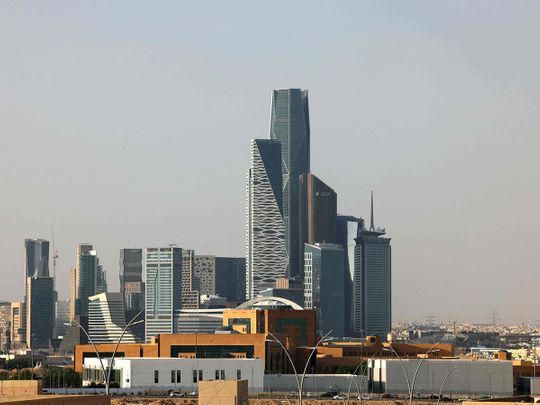Saudi Arabia's stock market ended higher due to an increase in oil prices, but gains were limited as investors awaited further interest rate insight from the U.S. Federal Reserve.
The Saudi government's efforts to diversify the economy away from oil and promote private sector growth are showing progress across four dimensions: exports, output, government revenue, and employment, although oil remains a dominant force in the economy.
Weak manufacturing data in major economies led to a decrease in oil prices, despite a larger-than-expected drop in U.S. crude stocks, while market focus is on Federal Reserve Chair Jerome Powell's speech on interest rate outlook, and Iran's oil output is predicted to increase despite U.S. sanctions.
The foreign exchange reserves of the State Bank of Pakistan fell below $8 billion for the first time in five weeks, dropping to $7.93 billion, which may pose challenges as the country faces significant debt servicing payments.
India's foreign exchange reserves have fallen to a two-month low of $594.89 billion due to a decline of $7.27 billion, the largest weekly fall in over six months, as the rupee dropped to a 10-month low against the U.S. dollar.
Saudi Arabia's robust diversification efforts, driven by Vision 2030 strategies, have resulted in a surge of business activities and economic growth, despite worldwide economic uncertainty and concerns over inflation and geopolitical tensions. The country's economic diversification journey has led to the opening of new sectors and advancements in fields such as tourism, media, finance, and clean energy, making it a regional economic and technology hub. Saudi Arabia's continued focus on sectors like mining, metals, hospitality, tourism, and clean energy, along with fiscal consolidation efforts and revenue-enhancing measures, are key to sustaining its economic diversification model.
Saudi Arabia's Tadawul All Share Index has experienced a significant decline due to poor performance from larger listed companies in sectors such as banking, energy, and materials, while stocks outside of these sectors have boosted the index; however, analysts believe the market to be fundamentally strong and see selloffs as buying opportunities due to transformative reforms and incentives implemented by Saudi Arabia under the Vision 2030 program.
Most stock markets in the Gulf ended lower due to a slightly hawkish outlook from the US Federal Reserve, with Abu Dhabi, Qatar, and Saudi Arabia experiencing declines.
Saudi Arabia, as a new member of the BRICS economic alliance, plans to invest $16 billion from its foreign reserves, signaling a shift towards prioritizing investment over reserves and potentially bolstering the bloc's ongoing initiatives.
Saudi Arabia's Tadawul All Share Index dropped 35.42 points, or 0.31 percent, to close at 11,455.78, with a total trading turnover of SR4.31 billion ($1.146 billion) and 106 stocks advancing and 104 declining.
Saudi Arabia plans to invest up to $25 billion in Pakistan over the next few years, focusing on sectors such as mining, agriculture, and information technology, in an effort to increase foreign direct investment and aid Pakistan's economic recovery.
Lebanon's private sector experiences a decline in business conditions in August, with the purchasing managers' index falling to a seven-month low, as output and new orders decrease amid the country's ongoing economic crisis.
Analysts predict that Saudi Arabia may face an economic contraction in 2023 due to its decision to extend crude production cuts, highlighting the nation's heavy reliance on oil, while a large dividend from Saudi Aramco may provide some cushion for public finances.
If Saudi Arabia continues to keep its output low, oil prices could surpass $100 as the market has yet to experience the full impact of its production cuts, according to Vortexa.
The price of oil is surging as Saudi Arabia and Russia cut output, creating a supply deficit that is driving up prices and threatening a fragile global economy with inflation and potential interest rate hikes.
Most stock markets in the Gulf rose in response to a rise in oil prices, except for the Saudi index which closed lower; however, the International Monetary Fund predicts a further slowdown in Saudi Arabia's GDP growth due to the extension of oil production cuts.
Oil prices fell due to a stronger US dollar and concerns about Chinese economic growth, but were supported by extended supply cuts by Saudi Arabia and Russia.
The United States is in regular contact with Saudi Arabia to ensure a stable and affordable supply of energy to global markets, according to National Security Advisor Jake Sullivan. This comes as cuts in oil output by Saudi Arabia and Russia are expected to result in a significant market deficit.
Gas prices in the US have reached their highest level in 11 months, posing challenges for the Federal Reserve in its campaign to control inflation. Factors contributing to the increase include rising oil prices, production cuts by Saudi Arabia and Russia, reduced refinery production due to hot weather, and low reserves in the Strategic Petroleum Reserve. However, prices are expected to decrease with the switch to a cheaper gasoline blend in the fall and projected global economic slowdown in 2024.
